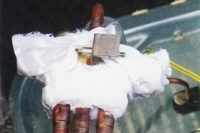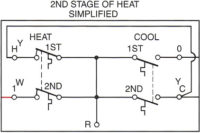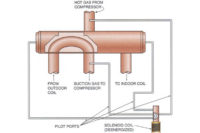Now, Bob’s company has promoted him to help train a new employee, right out of a school specializing in HVAC, just like Bob was. Bob is now Tim’s Btu Buddy. Tim is anxious to travel with Bob. Tim realizes that he is right out of school, with the theory and lab work that he accomplished in school, but still needs help. He knows that he worked with many of the components of the systems in the school, under ideal conditions with good light and air conditioning. Now it is into the field, sometimes under the house with poor lighting, or out on the rooftop in the sun, where the real action is. He is naturally and normally reluctant, but he has Bob to help guide him.
Bob and Tim were on their way to a service contract routine procedure when the dispatcher called and asked them to go to a residence that had no heat and had a very sick family member. They needed heat as quickly as possible.
They arrived and talked to the husband who explained, “The heating system was working great last night. However, this morning it is running, but not heating enough. My mother is living with us and she has the flu and the house is getting cold.”
The system was a heat pump with three strip heating elements for emergency and auxiliary heat. The weather was really cold, about 20°F during the day.
Bob and Tim went to the air handler to see what they could discover.
Bob felt the hot gas line at the indoor coil and said, “Tim, feel this line and tell me what you think.”
Tim felt the line and said, “The line is cold, and it should be hot. The unit must be in defrost.”
Bob said, “Use your ammeter and check to see how many of the strip heat coils are pulling current (Figure 1).”
Tim checked the heater leads with his ammeter and said, “The amperage should be about 20 amps per heater. Only two of the heaters are pulling amperage. It is no wonder the system is not heating the house. The heat pump is operating in the cooling mode and only two of the strip heaters are working.”
Bob said, “The question is, why is the system running in the cooling mode? Is it stuck in defrost? Is the thermostat calling for cooling? Is the four-way valve stuck in the cooling mode?”
Tim asked, “How are we going to determine what it is?”
Bob responded, “We must let it continue to run and see if the defrost circuit is making a call for defrost or if the controls are calling for heating. Look at the diagram and let’s see when the four-way valve is supposed to be energized.”
Tim looked over the diagram and said, “It looks like it should be energized in the cooling mode (Figure 2).”
Bob said, “Let’s go and see if the ‘O’ (orange) terminal is energized in the outdoor unit. If it is energized, we have a control problem. It is calling for cooling. If it is not energized, we have a valve problem. It is stuck in the cooling mode.”
They went to the outdoor unit and removed the cover to the low voltage wiring and Tim checked for a 24V signal and said, “There is no voltage here. I guess the valve is bad.”
Bob said, “Before we condemn the valve, let’s check the voltage at the valve terminals. It could still be getting a signal from the defrost circuit which could keep it energized.”
Tim said, “I didn’t think of that.”
Then he checked the wires going to the four-way valve and said, “There is no voltage to the valve coil and it is still in the cooling position.”
Bob then said, “We might break the valve loose. Sometimes that works and sometimes if you break it loose, it will hang again in the future.”
Tim asked, “How do you break the valve loose?”
Bob explained, “Jump out from the ‘R’ terminal to the ‘O’ terminal by just touching the jumper to the terminals several times.”
They did this procedure and could hear the click of the pilot valve, but the main slide valve did not change over to heating when they removed the jumper.
Bob then said, “Use the rubber soft face hammer and tap the valve several times from different directions.”
Tim did that and it stayed the same.
Bob then said, “Shut off the disconnect. That will cause the pressures to change. Wait about three minutes and start the unit up again and see if the valve shifts positions.”
Tim shut the unit down for a few minutes and started it up again. It was still in the cooling mode.
Bob said, “I don’t think there is any hope for that valve. The best we can do now is disconnect the ‘R’ wire to the outdoor unit, which will shut it down, and come back on a warmer day to change the valve. Changing the valve is a real process that has to be done correctly.”
Tim asked, “Why not just pull the electrical disconnect until we come back?”
Bob answered, “This unit uses R-22 as the refrigerant and R-22 has a great affinity or attraction to refrigerant oil. When we come back in a few days, most of the liquid refrigerant will be in the compressor where the oil is. It will make it hard to recover the refrigerant from the oil so we can change the four-way valve. It will save us time to keep the crankcase heat on to the compressor.”
Tim disconnected the wire and then asked, “Don’t we need to get that other strip heater working? With all three strips working, the house may have enough heat to be comfortable.”
Bob said, “Yes, I was going to mention that. I am glad that you remembered it also. Let’s repair the strip heat and talk to the owner.”
They found a loose connection on one of the strip heaters that caused it to overheat the thermal overload and it had to be manually reset. They had to repair the connection by stripping the wire back to solid copper with a good color, because the wire had really been hot.
After the repair, they started the system back up using only the strip heat. They had the homeowner put some pots of water on the kitchen stove to supplement the heat.
Tim asked, “Why use boiling water? Why not just turn on a couple burners on the stove top?”
Bob explained, “By boiling water, they keep from overheating the electric heating element and the boiling water will add some humidity to the house. They need to keep an eye on the boiling water and not let the pots boil all of the water away or the pot may be damaged.”
Bob explained to the owner, “You probably only need to boil the water for a couple of hours, to give the strip heaters time to get the home comfortable. Then, the strip heaters alone should heat the house. We will be back on Wednesday to change the valve and get the heat pump working again. The weather is supposed to be warmer then.”
(Continued next month.)
Publication date: 3/18/2013









